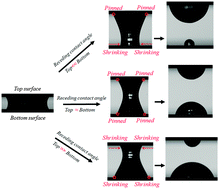How pinning and contact angle hysteresis govern quasi-static liquid drop transfer†
Abstract
This paper presents both experimental and numerical simulations of liquid transfer between two solid surfaces with contact angle hysteresis (CAH). Systematic studies on the role of the advancing contact angle (θa), receding contact angle (θr) and CAH in determining the transfer ratio (volume of the liquid transferred onto the acceptor surface over the total liquid volume) and the maximum adhesion force (Fmax) were performed. The transfer ratio was found to be governed by contact line pinning at the end of the transfer process caused by CAH of surfaces. A map based on θr of the two surfaces was generated to identify the three regimes for liquid transfer: (I) contact line pinning occurs only on the donor surface, (II) contact line pinning occurs on both surfaces, and (III) contact line pinning occurs only on the acceptor surface. With this map, an empirical equation is provided which is able to estimate the transfer ratio by only knowing θr of the two surfaces. The value of Fmax is found to be strongly influenced by the contact line pinning in the early stretching stage. For symmetric liquid bridges between two identical surfaces, Fmax may be determined only by θa, only by θr, or by both θa and θr, depending on the magnitude of the contact angles. For asymmetric bridges, Fmax is found to be affected by the period when contact lines are pinned on both surfaces.


 Please wait while we load your content...
Please wait while we load your content...